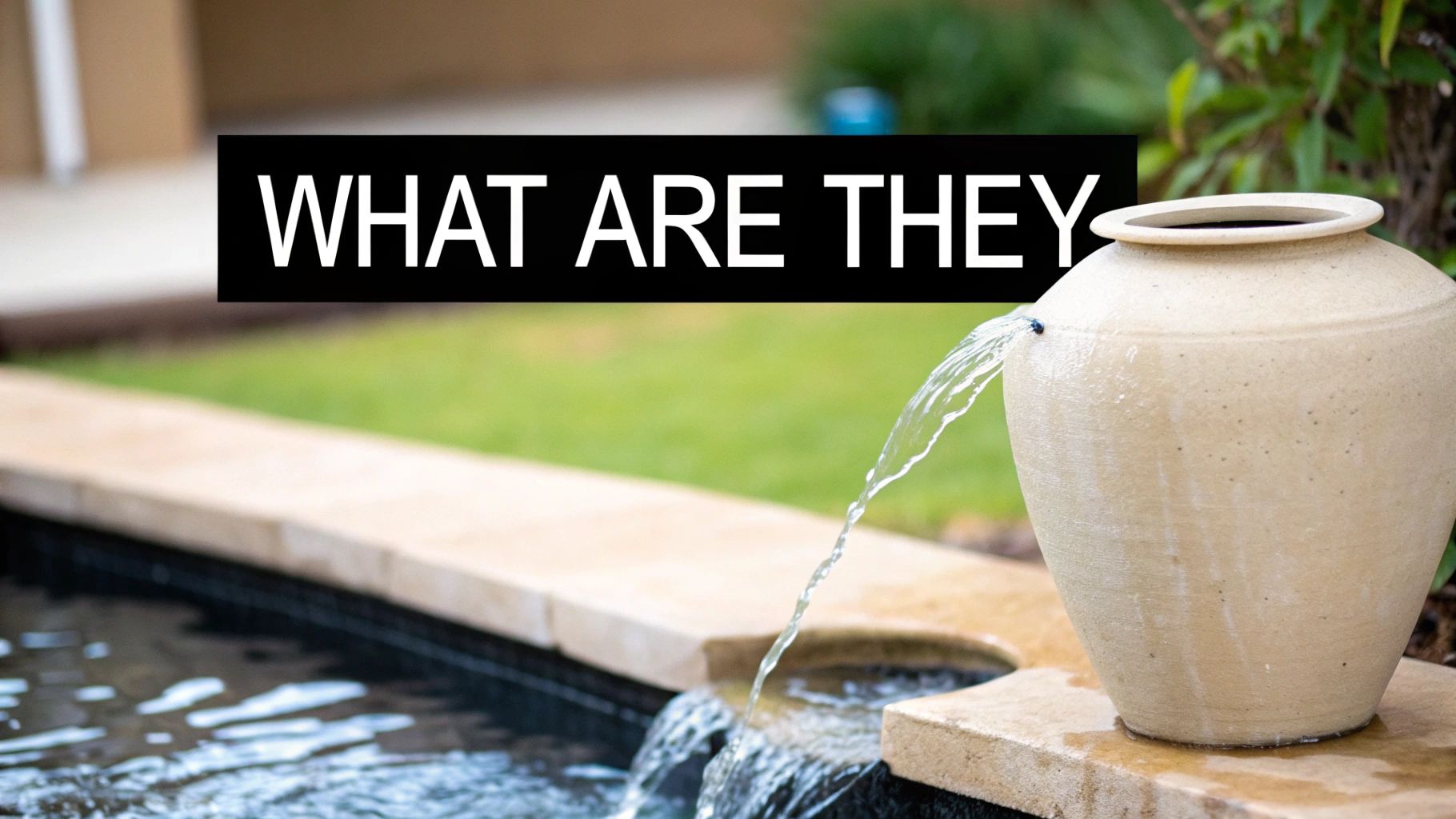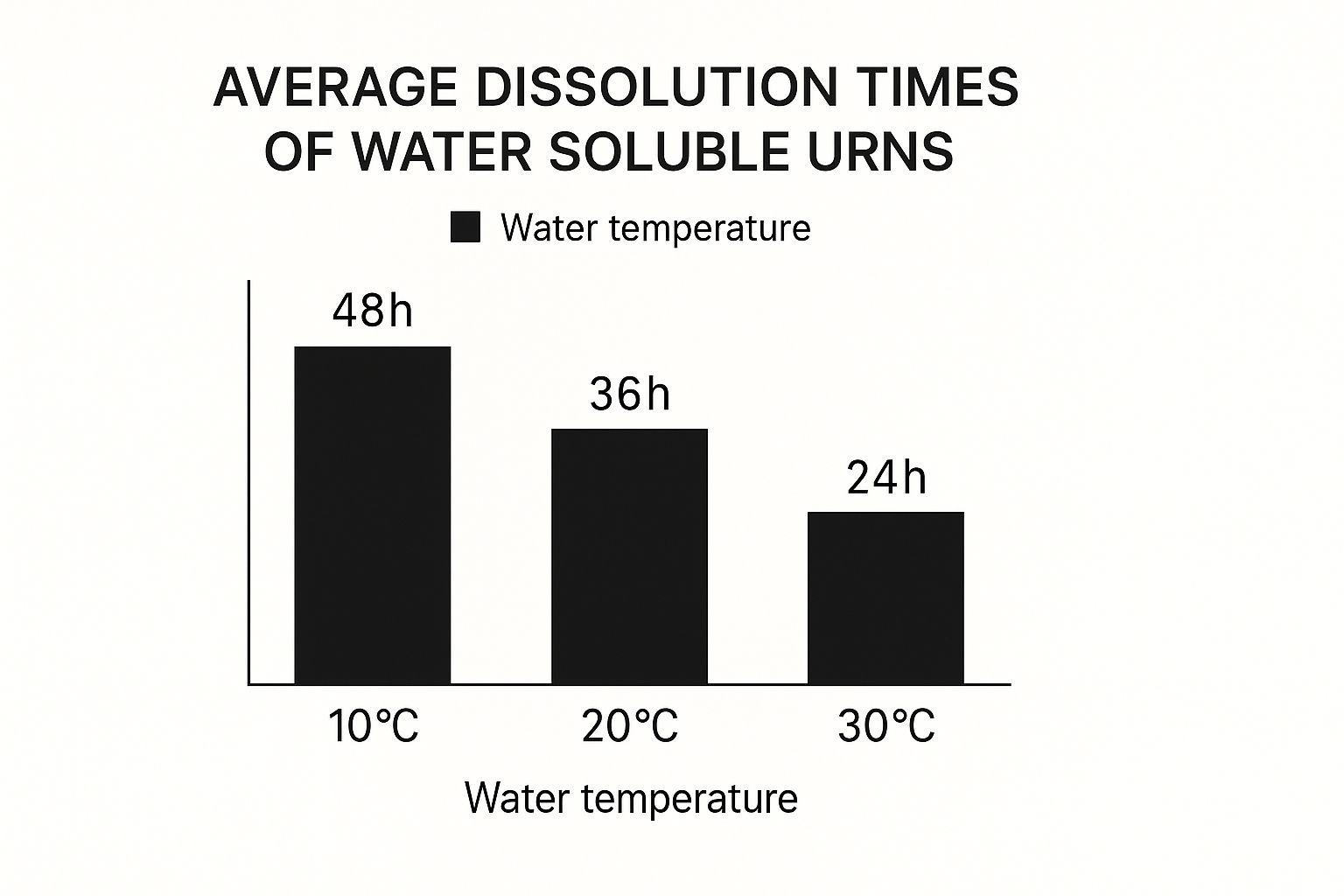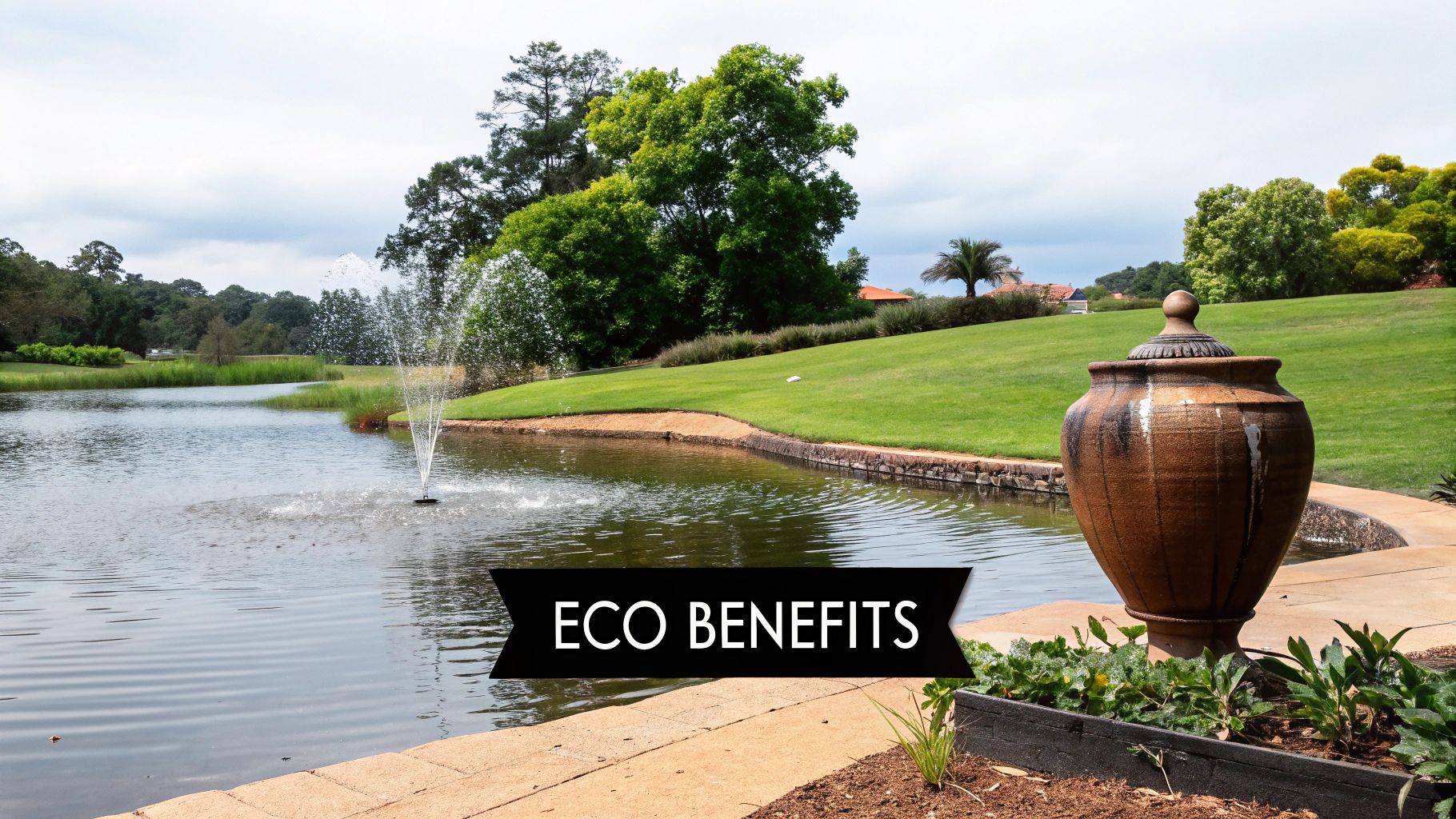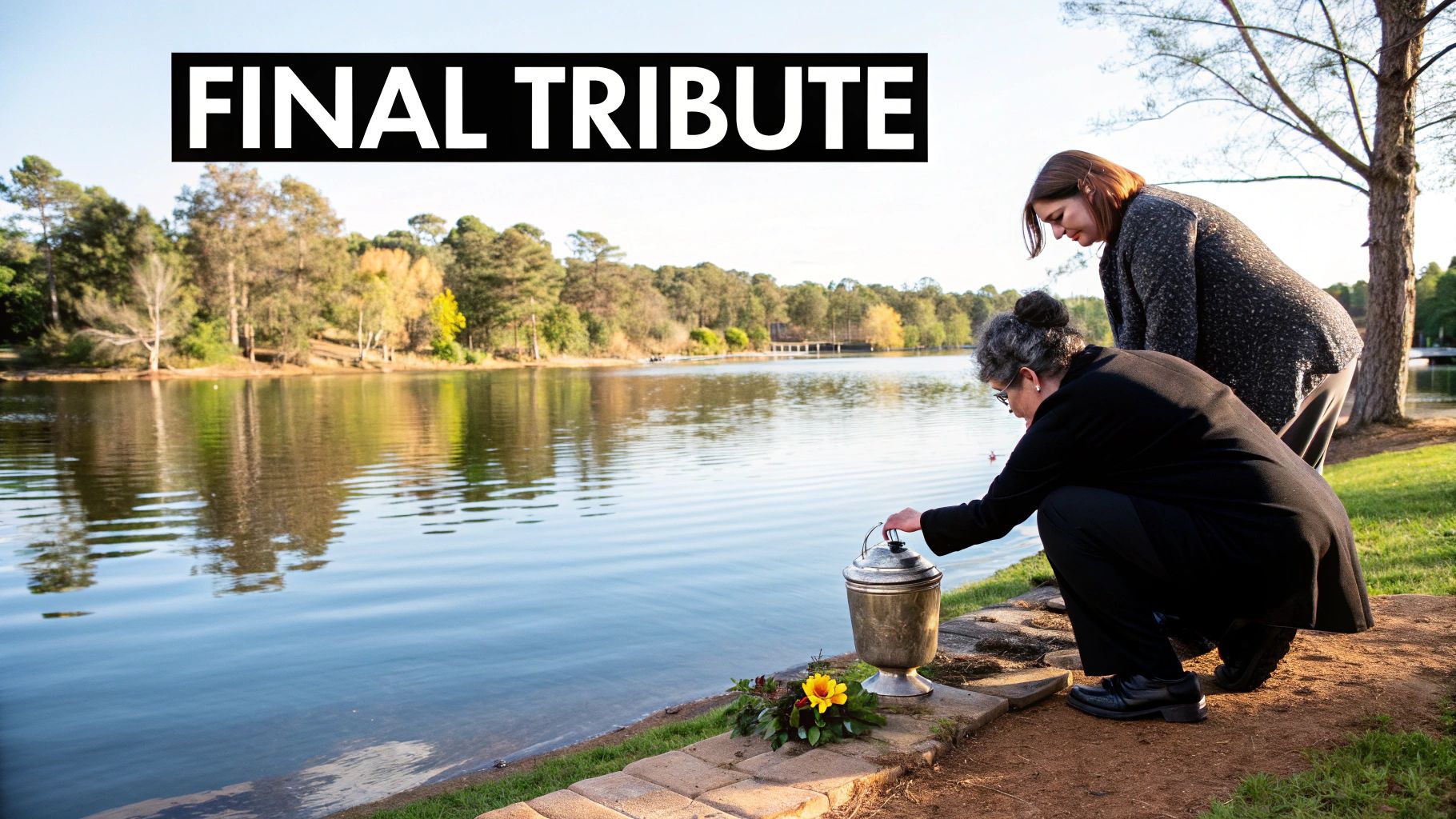Water soluble urns are a unique and gentle way to return a loved one’s ashes to nature. They are specially designed biodegradable containers, crafted to dissolve completely when placed in water.
This approach offers an eco-friendly and deeply symbolic final tribute. Because they're made from natural materials like recycled paper, sand, or salt, these urns break down without leaving any harmful residue behind.
Understanding Water Soluble Urns for a Final Farewell

Choosing a final resting place is an incredibly personal decision. For those who felt a deep connection to the ocean, a favorite lake, or a peaceful river, a water ceremony often feels like the most fitting farewell. Water soluble urns are designed precisely for these moments.
Unlike traditional metal or ceramic urns, which are built to last forever, these are engineered to gracefully disappear. Think of an urn made from compressed sand and a gelatin binder. It’s sturdy enough to handle for the ceremony, yet once it's placed in the water, it begins its final journey.
Most of these urns will float for a few minutes, giving family and friends a moment for quiet reflection and to say their last goodbyes. Then, it slowly sinks beneath the surface. Over the next several hours, it gently breaks apart, releasing the ashes back into the ecosystem in a natural, unobtrusive way.
This method of scattering ashes connects with a growing desire for end-of-life choices that honor a person's love for the natural world. It can provide a profound sense of closure, symbolizing a peaceful return to the elements.
At Aerial Ash Scattering, we understand just how important this final tribute is. We help families find the right water soluble urn and plan a ceremony that is both meaningful and fully compliant with environmental regulations, ensuring a serene farewell for your loved one.
What Goes Into a Water Soluble Urn?
The real beauty of a water soluble urn lies in its humble, natural ingredients. These urns are thoughtfully designed to be both strong enough to hold a loved one’s ashes during a ceremony, yet gentle enough to completely dissolve and return to the environment. They're a perfect fusion of natural artistry and practical science, meant for a peaceful farewell.
Most often, you'll find these urns are crafted from materials like recycled paper, sand, rock salt, and even plant-based binders. Think of it like a sturdy papier-mâché or a solid sculpture made of compressed sand and salt—it holds its form beautifully above water but is designed to break down gracefully once it meets the waves. This allows the ashes to be released gently and become part of the water.
How They Return to Nature
The time it takes for a water soluble urn to dissolve isn't a one-size-fits-all answer. It really depends on the specific material and, just as importantly, the water itself. For instance, an urn carved from Himalayan rock salt will naturally break down faster than one made from layers of compacted mulberry bark paper.
This is a key detail to keep in mind when you're planning a water burial ceremony.

As the image shows, warmer water acts as a catalyst, significantly speeding up the dissolution. A quicker process can often feel more seamless and immediate during a ceremony, helping create a powerful moment of release.
The move towards sustainable end-of-life options is more than just a passing thought; it's a significant shift. In 2024, the global market for all types of degradable urns was valued at around USD 150 million. That number is projected to double by 2033, which really speaks to how many people are seeking more environmentally mindful ways to honor their loved ones.
Comparing Common Water Soluble Urn Materials
To give you a clearer picture, let's break down the common materials used in these eco-friendly urns. Each one offers a unique combination of dissolution time and environmental benefit.
| Material | Estimated Dissolution Time | Key Environmental Benefit |
|---|---|---|
| Recycled Paper | 5-15 minutes | Made from post-consumer waste, reducing landfill burden. |
| Sand & Gelatin | 5-20 minutes | Composed of natural earth elements, leaving no synthetic residue. |
| Himalayan Rock Salt | 2-4 hours | Dissolves into the water, adding natural minerals back to the ecosystem. |
| Cornstarch | 1-2 days | A plant-based polymer that biodegrades completely without harm. |
As you can see, the choice of material directly influences the experience of the water burial ceremony and the urn's final impact on the environment.
Selecting an urn is just one part of the journey after a cremation. For more inspiration on creating a fitting tribute, you might find some solace and great ideas in our guide on 12 meaningful memorial ideas for what to do with ashes after cremation.
Here at Aerial Ash Scattering, we're here to help families navigate these choices. We can help you find an urn that not only reflects your environmental principles but also provides a dignified and beautiful final resting place that honors the life it represents.
Environmental and Symbolic Benefits of Water Soluble Urns

Choosing a final tribute is a deeply personal decision. For those who feel a connection to the water, water soluble urns offer a way to honor a loved one while also respecting the planet.
Their main environmental benefit is simple but powerful: they prevent materials like plastics, metals, and chemical lacquers from polluting our delicate aquatic ecosystems. Instead of leaving behind a permanent object, the urn dissolves cleanly, leaving no trace.
This eco-conscious approach ensures a final farewell doesn’t add to waterway pollution, aligning with a desire to leave a legacy of care for the natural world.
The shift toward greener end-of-life choices is more than a feeling; it's a measurable trend. The cremation urn market was valued at about USD 1.8 billion globally in 2021 and is projected to hit USD 2.2 billion by 2025. This growth signals a real demand for sustainable options, and water soluble urns are a huge part of that conversation. You can see more on this market trend and how environmental awareness is shaping consumer choices.
A Ceremony of Release and Closure
Beyond the ecological pluses, the symbolic nature of a water scattering ceremony is incredibly powerful. There’s a tangible, peaceful moment of release in watching the urn float briefly before it gracefully sinks and becomes one with the water.
This act represents a gentle return to the elements, providing a profound sense of closure for grieving families and friends.
This quiet, final journey can be an incredibly healing experience. It transforms a moment of loss into a beautiful and final act of love, connecting the memory of the individual with the timeless rhythm of the ocean or a quiet lake.
The team at Aerial Ash Scattering specializes in helping families create these meaningful tributes. A water ceremony is so much more than just scattering ashes; it's a profound gesture that merges a loved one’s final resting place with the vastness of nature.
Of course, planning a ceremony also means understanding the rules. To make sure your tribute is both beautiful and compliant, take a look at our complete guide on where you can scatter ashes legally and respectfully.
Planning a Meaningful Water Scattering Ceremony
A water scattering ceremony is a beautiful and deeply personal way to say a final goodbye. It's a chance to create a peaceful, final tribute, and using a water soluble urn makes that farewell both moving and kind to the environment. The real art is in blending those personal, heartfelt touches with the practical details to make sure the day flows smoothly.
The first, and perhaps most important, step is choosing a location that feels right. Think about a place that held special meaning for them. Was it a particular stretch of coastline they loved, a quiet lake where they felt at peace, or a river that seemed to capture their free spirit? This decision really sets the stage for everything that follows.
Once you have a location in mind, you'll need to look into the local rules. It's a crucial step. For example, in the U.S., the EPA has a clear guideline for ocean scatterings: they must take place at least three nautical miles from the shore. When it comes to inland waters like lakes or rivers, the regulations can differ quite a bit from one state or county to the next.
Making the Ceremony Their Own
What truly transforms the act of scattering ashes into a lasting, cherished memory is making it personal. This is your opportunity to honor the unique life they lived. Weave in elements that speak to who they were.
Here are a few ideas to create a truly meaningful tribute:
- Share Memories: Ask friends and family to come prepared with a favorite story.
- Play Their Music: A playlist of their most-loved songs can create a powerful atmosphere.
- Read Something Special: Choose a poem or a passage from a book that reflects their spirit or your love for them.
- Toss Flowers: After placing the urn in the water, guests can toss flower petals as a final gesture.
This desire for personal, eco-conscious farewells is definitely on the rise. Water soluble urns are a key part of the growing biodegradable urn market, resonating with families who want a respectful and natural final act. This is especially true in North America, where environmental awareness and higher cremation rates have created more demand for options like urns made from water-soluble polymers or paper. You can explore more on the growing degradable urns market for a deeper look.
The ceremony is a final gift—a carefully crafted moment of remembrance. It’s about creating a space for collective grieving and celebrating a life well-lived, all while honoring the natural world they loved.
Pulling all these details together can feel like a heavy weight, but you aren't in this alone. At Aerial Ash Scattering, we guide families through every step, from clarifying legal requirements to handling the logistics of the day. Our whole purpose is to help you create a ceremony that is both compliant and beautifully memorable. For more tips on the process, you might find our article on how to scatter ashes in a meaningful way helpful.
How to Choose the Right Water Soluble Urn

Choosing a water-soluble urn is a deeply personal decision. The right vessel is more than just a container; it's the centerpiece of a final, fitting tribute to a unique life. The goal here is to find a balance between the practical aspects of the ceremony and the spirit of the person you're honoring.
First, think about where the scattering will take place. An urn designed for a calm lake might differ from one built for the ocean's tides. The size of your gathering also matters. A larger, more central urn might be perfect for a big family ceremony, whereas a smaller, simpler one can feel right for a more intimate moment.
Matching the Urn to Their Personality
Beyond the logistics, the urn's design should feel like a true reflection of your loved one. At Aerial Ash Scattering, we see a wide variety of water soluble urns, from beautifully simple to ornately artistic styles.
Here are a few ideas to get you started:
- For the Naturalist: Consider an urn made from sand or Himalayan rock salt. These materials honor a deep love for the earth's raw beauty.
- For the Artist: A vessel with hand-painted details or a unique, sculpted shape can be a wonderful nod to a creative spirit.
- For the Minimalist: A simple, unadorned paper or gelatin urn provides a dignified and understated farewell.
Think of the urn as the final chapter in their story. When you choose one that truly captures their character, it adds a powerful layer of meaning to the ceremony, making the goodbye feel authentic and heartfelt.
Ultimately, the aim is to find an urn that feels right to you and celebrates their memory in a way they would have loved. Making this choice is a key step in planning a tribute that brings both peace and closure. For a complete guide to planning the service itself, you can learn more about organizing a meaningful ash scattering ceremony.
Common Questions About Water Soluble Urns
Choosing a water-soluble urn is a deeply personal decision, and it’s natural to have questions. You want the ceremony to be meaningful and go smoothly, and understanding the practical side of things can bring a great deal of comfort. Let's walk through some of the most common questions we hear from families.
First off, many people wonder about durability. How sturdy can an urn be if it's designed to dissolve in water? It’s a fair question. These urns are actually quite robust and reliable, engineered to stay completely intact as long as they are kept dry. Their beautiful transformation only begins once they are placed in the water, so you can feel confident handling and transporting them to your chosen location.
How Long Does It Take for the Urn to Dissolve?
This is probably the most-asked question. The time it takes for a water-soluble urn to dissolve really depends on its material and the specific water conditions.
Most are designed to float gracefully for a few minutes—anywhere from 5 to 15 minutes is typical—giving everyone a moment to say their final goodbyes before it slowly descends. Once it slips beneath the surface, the process usually finishes within a few hours to a full day.
Several factors can affect this timing:
- Water Temperature: The process is faster in warmer water and slower in colder water.
- Water Movement: An urn placed in the ocean or a flowing river with currents will break down more quickly than one in a calm, still lake.
- Urn Material: Lighter materials like sand, salt, or paper dissolve faster. Denser urns, perhaps made from gelatin, will take a bit longer.
The team at Aerial Ash Scattering can give you the specific dissolution time for any urn you’re considering, which helps immensely when planning the ceremony.
Navigating the Legal Side of Things
Another major consideration is the legality of a water scattering. While it's a widely accepted practice, there are rules you need to follow, and they can change depending on where you are.
For instance, in the United States, the Environmental Protection Agency (EPA) has clear guidelines for ocean scatterings: they must take place at least three nautical miles from the shoreline.
When it comes to inland waters like lakes, rivers, or streams, the rules fall under state and local jurisdiction. It's crucial to check the specific regulations for your area before you make any final plans.
Doing this homework upfront ensures your ceremony is respectful of both the environment and local laws. To get a comprehensive overview, you can read our complete guide on if it is legal to spread ashes. Knowing you're following the rules lets you focus entirely on the tribute, free from any stress or uncertainty.
At Aerial Ash Scattering, we are here to help you create a dignified and beautiful farewell. Explore our options for meaningful water ceremonies at https://ashdive.com.


